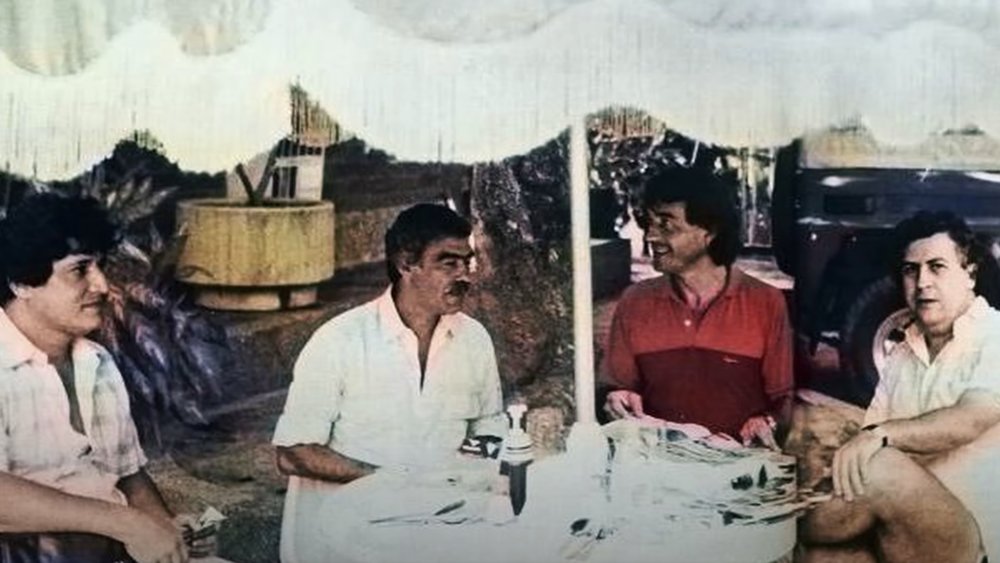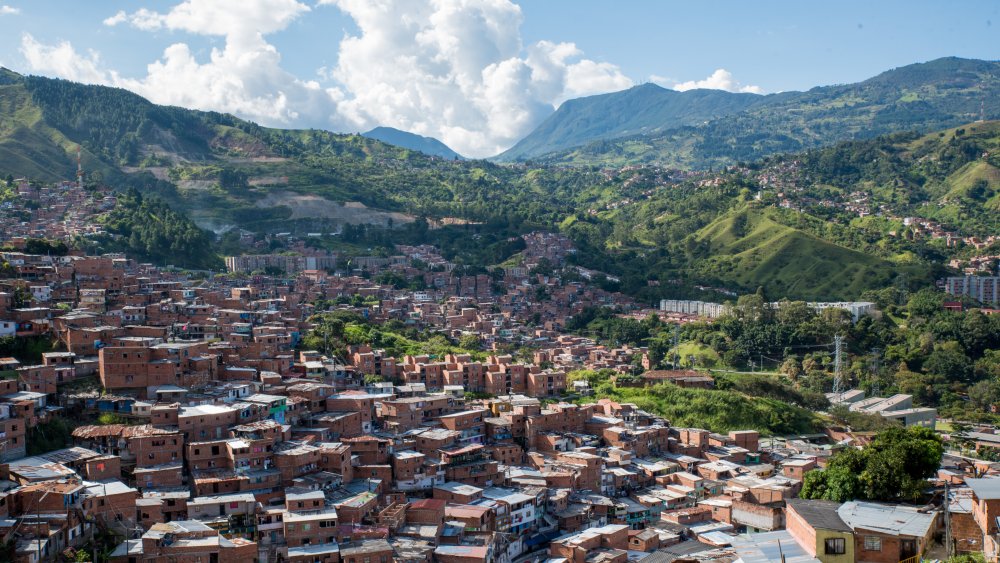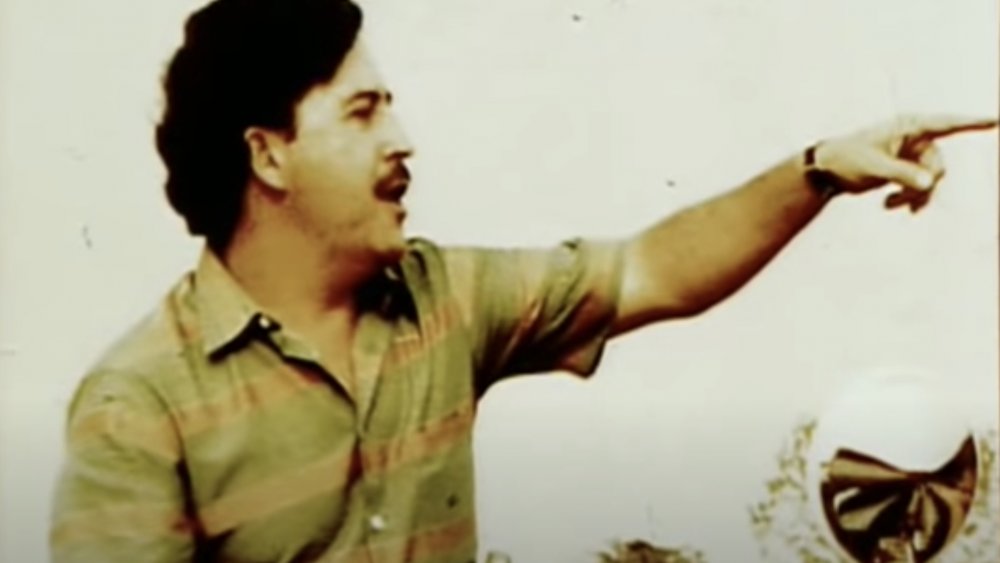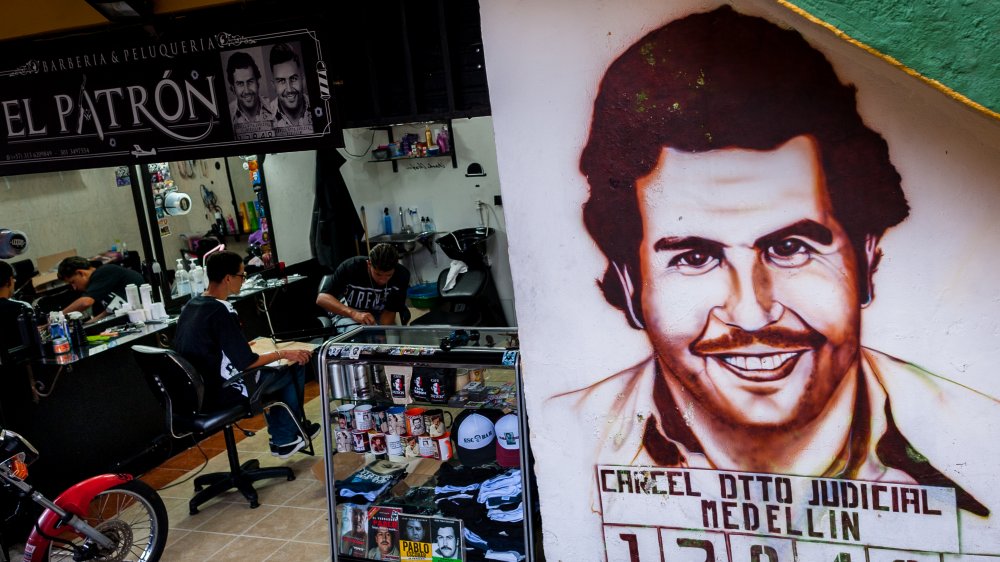The Untold Truth Of The Medellin Cartel
Many terrifying truths have been told of the infamous Medellin Cartel. Thank you, Netflix! If untold truths are still out there of the Cartel and its cocaine-crazed capers across Colombia, they're probably safely tucked away inside the aging brains of people who have a deep personal interest in keeping their mouths tightly shut. But some corners of the Medellin Cartel story aren't dark and terrible secrets. They're merely uncomfortable realities that decently-inclined citizens choose to ignore. These truths are history's equivalent of an old and abandoned pair of underpants on a communal trailer park clothesline: rotting; unclaimed; yet eternally fluttering at the corner of humanity's myopically shifting eye. There are many of these kinds of truths to be uncovered when it comes to the Medellin Cartel.
First, some context. As Business Insider reports, the Medellin Cartel was hauling in $420 million each week at the height of its operations across Colombia. The Cartel wielded the torrential economic might of a Fortune 500 Company with none of the regulatory inconveniences that come with that legitimacy. People died — a lot. Over 4,000 people likely snuffed it at the hands of the Medellin Cartel. One thousand police officers, 200 judges, even one Colombian presidential hopeful became prematurely acquainted with the underside of a coffin-lid simply because they became ensnarled in the Cartel's grimy tendrils. We know the Medellin Cartel was ruthless in how it made money; that's common knowledge. But a less spoken truth lurks behind the Medellin Cartel's methods.
The Medellin Cartel Weaponized Poverty
Let's take a closer look at Pablo Escobar, and the diabolical charisma he wielded like a bedazzled, blood-stained baseball bat. Walk down some of the most poverty ravaged streets of Medellin, and you'll find large apartment complexes bearing his name. Sit at the right bar (it's probably more accurate to say the wrong bar) and ask folks about Escobar. You'll still find Medellin locals who'll fiercely defend his memory. Interviewed for a Wall Street Journal article on Escobar's lasting influence, Former US Drug Enforcement Agency officer, Javier Peña, explains that Escobar remains a Robin Hood figure for poor and marginalized people of Colombia. "Escobar rallied support among Colombia's poorest citizens by stepping in where the government couldn't or wouldn't. [...] Even today, people praise him for what he did for their families and community." Hundreds, possibly thousands, of Colombians living on the very edge of life-destroying squalor have a better existence today because The Cartel housed and fed them when it was a matter of life or death.
And, of course, The Medellin Cartel used that potent blend of poverty and loyalty to their advantage. The Cartel placed bounties on the heads of anyone in their way, most often Colombian police officers that were a little too brave — or incorruptible — for their own good, and it left a trail of blood thousands of lives wide. As the Wall Street Journal reports, many of the cop slayings were carried out by poor urban youth who were as sympathetic to The Cartel as they were desperate for money. Bounties of up to $3,000 amounted to a life-changing fortune.
So here's one less-spoken truth about the Medellin Cartel. Following Escobar's lead, the Medellin Cartel successfully weaponized poverty ... and it was brutally effective.
The Medellin Cartel thrived thanks to a potent creative partnership
The Medellin Cartel had Pablo Escobar. No ordinary crook, Escobar was the Energizer Bunny of ruthlessness. Another drug-smuggling kingpin might set humanity aside to commit rare acts of desperate brutality when cornered. They might even have the moral flexibility to describe these moments as a necessary part of their line of work. Escobar would shrug, draw a swig of beer, and call it Thursday. Escobar's power was the kind that comes with madness. He tied up and drowned a servant in his swimming pool for stealing silverware. He bought pet hippos— actual hippos — that poop everywhere. Escobar was Heath Ledger's Joker in the infamous pencil scene, only twenty pounds overweight, rich as Bezos, and wearing a dodgy island-print polyester shirt.
Escobar's right hand man
Then you have Escobar's cousin, Gustavo de Jesus Gaviria Rivero. Perhaps surprisingly for a dude whose name reads like it should be stitched in sequins on a velveteen handkerchief, Rivero was gifted with the quietly sensible cunning of a weasel with an MBA. He was the one who developed the convoluted routes the Cartel used to shift their product. He was the guy who conceived the plan of conscripting chemists to conceal cocaine in seemingly harmless Colombian exports. Rivero built systems. He brought order to Escobar's penchant for murder and mayhem.
Some creative partnerships are made in heaven. Steve Jobs' had Wozniak. McCartney had Lennon. One rarely-spoken truth of the Medellin Cartel is that it flourished thanks to a similar convergence of two strangely brilliant people. The Medellin Cartel had the same potent stuff that made The Beatles more than a skiffle band; Apple more than a gnatty line of upmarket calculators. Perhaps some creative partnerships are made in hell.



